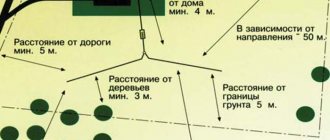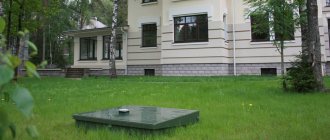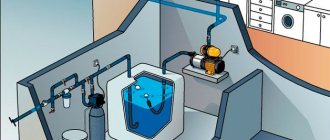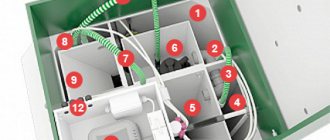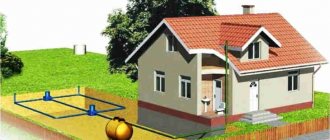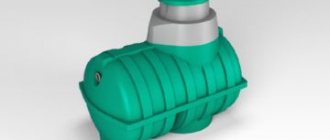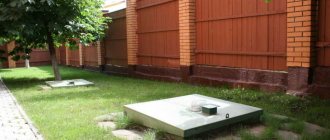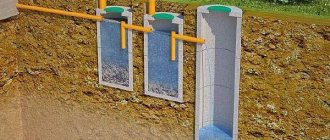The septic tank must be inexpensive and effective - to solve the problem of wastewater disposal, steel barrels, factory-made plastic containers, and ready-made reinforced concrete rings are used. But they forget that you can make a septic tank out of brick with your own hands - and completely in vain. After all, for such construction you will not have to purchase expensive materials, but you can get by with the remains of bricks after dismantling a building.
Device, types, diagram
It uses the technology of settling domestic wastewater coming from operating individual facilities, followed by biological purification. The design of local buildings is based on the legal requirements for the sewage system of a private house and the rules of SNiP.
The design of the sedimentation tank consists of individual containers or a solid structure divided into compartments connected to each other by water seals.
The material for the manufacture of treatment facilities can be concrete, brick, metal or plastic. Depending on the volume of processed household and household waste, septic tanks are divided into types:
- single-chamber, no more than 1 m3/day goes into treatment;
- two-chamber, process from 1 to 10 m3/day;
- consisting of three chambers, with an additional filter well, wastewater flow is more than 10 m3/day.
For year-round operation, external sewer pipes and a sump are buried in the ground below the freezing level.
The choice of design depends on the use. During the seasonal period of operation, an inexpensive, sealed, single-chamber septic tank with waste pumping is advisable. For permanent residence, it is better to use a multi-chamber with 100% waste treatment.
Construction of a purification structure made of monolithic concrete
Structures made of monolithic concrete are characterized by durability and increased strength.
Advantages of a monolithic treatment plant:
- practicality;
- long service life;
- availability of materials used for construction;
- high degree of waterproofing.
Important! The basis for the construction of a monolithic structure is formwork. Its implementation is mandatory. The most suitable material for these purposes are panels made of OSB boards. This type of material has good moisture resistance, and its cost is significantly lower than that of panels made from wooden boards.
Diagram of a concrete septic tank: A - septic zone; B - zone of anaerobic digestion; C - biofilter; D—receiver-storage facility for treated wastewater; 1, 1a - metal case; 2 - bypass holes; 3 — bypass between sections; 4 - anti-floating base; 5 - pump; 6 — secondary cleaning pipe; 7 - check valve; 8 - polystyrene foam; 9 - cover; 10 - pipe for biogas removal
- high construction costs;
- the need to provide a reinforcing base;
- construction of a formwork structure is a mandatory procedure;
- low level of throughput.
Before concreting the bottom of the chambers, a reinforcing mesh is laid at the initial stage of construction. To prevent corrosion damage to the metal, a thick layer of concrete should be placed in this area. The minimum thickness of the concrete layer above the mesh is 3 cm.
The procedure for making a septic tank with your own hands: 1 - preparing a pit and supplying pipes; 2 - reinforcement; 3 - formwork device; 4 - concreting; 5 - removal of formwork; 6 — installation of metal corners; 7 - laying flat slate, designing hatches, cementing, installing a ventilation pipe; 8 — arrangement of the inspection shaft; 9 - waterproofing, insulation, filling with earth
The formwork structure and reinforcement reinforcement are being constructed. After that, the walls of the chambers are concreted and partitions are organized between them. At the final stage, the floors are poured with concrete. The drying period is about 2 weeks. It is recommended to cover the solution with film to ensure uniform drying.
Advantages and disadvantages of brick settling tanks
- Availability of material for the construction of the facility, the possibility of using used bricks (2 times cheaper than new ones).
- Reliability and long service life of the building with high-quality waterproofing.
- A choice of shape options is possible.
- With a certain skill, the possibility of self-production.
The disadvantages include:
- A reinforced foundation is needed for a heavy structure.
- The need for plastering and waterproofing the walls of the septic tank.
- Large amounts of time spent on construction.
Why is brick chosen?
Despite the high labor intensity of brickwork, a do-it-yourself brick septic tank finds many admirers, which is facilitated by the expanded capabilities of such construction and versatility. The popularity of brick is ensured by its following advantages:
- Availability and reasonable cost, as well as the possibility of using used material.
- High strength, ensuring reliability and durability of the structure.
- The ability to do the masonry yourself, which significantly reduces costs.
- Versatility. With the help of brickwork, almost any well scheme can be created (both simple storage and multi-chamber of any complexity).
- Manufacturability, making it possible to use standard sealants with high efficiency.
- Possibility of constructing a well of any capacity, size and shape (round, rectangular, polygonal).
The main disadvantages of brickwork are increased labor intensity and the need to apply protective covers with increased waterproofing properties. Without surface finishing of a brick wall, direct contact with water and harmful components of wastewater gradually destroys the material. Most often, direct contact with an aggressive environment is eliminated using plaster.
When building a brick septic tank, it is important to choose the right type of material. The most common option is ordinary red brick. It meets the requirements, but its durability is about 14-16 years, and during operation it requires periodic inspection to assess the condition of the walls. You should not use white sand-lime brick, because... in direct contact with water it will not last long. Of course, reliable protection increases its performance, but then constant monitoring of its integrity is necessary.
Clay clinker bricks can be considered an ideal material for the construction of septic tanks. It practically does not absorb moisture and has very high strength. There is no point in covering it with a protective cladding. The only drawback is the high cost, but the significantly increased service life covers the costs.
Selection and calculation of material
The need for materials and components is calculated in the design documentation, in accordance with the dimensions and layout. To build the structure you will need:
- Main materials: concrete, brick, floor slabs, reinforcement, sand, cement.
- Auxiliary: roll and penetrating waterproofing, plaster, plastic pipes, components for building the facility.
The number of sewer pipes and components for assembling and connecting the route to the chambers depends on the location of the sump.
Do-it-yourself installation of a sump pump for a private home
To build a brick septic tank yourself, you need the knowledge and experience of a mason builder.
Compliance with sanitary standards and operating rules depends on the quality of the brick used in construction, the accuracy of calculating the dimensions of the sump and the choice of wastewater treatment technology.
To ensure a positive result of the settling tank’s operation and to prevent mistakes during the construction of the facility, we carry out the work in accordance with the step-by-step instructions:
1 ) We determine a location on the site for the construction of a brick septic tank, taking into account the location of the water well and the buildings from which the drainage will be made.
2 ) We carry out a wastewater treatment plant project, taking into account the number of people living and the specifics of the facilities being operated on the site. The document reflects the soil structure, groundwater level, nomenclature and volume of necessary materials. The design drawings of three sections take into account the required volume of chambers for wastewater treatment:
- the receiving chamber for draining waste should occupy 50% of the volume of the room;
- the anaerobic treatment compartment occupies 30%;
- chamber with aerobic/anaerobic wastewater treatment without suspended matter - 20%;
- well or ground filtration field.
3 ) Based on the design data, we complete the facility with the necessary materials and equipment.
4 ) We prepare tools for work.
Using an excavator, we dig a pit of the required size. Its depth should ensure that the septic tank is installed below the freezing level of the soil.
5 ) We lay geotextile fabric at the bottom to protect drainage from groundwater, then a 300 mm thick layer of sand and crushed stone. We spread two layers of rolled waterproofing on the compacted drainage.
6 ) We make formwork from boards under a concrete base slab for the structure of the sump. We install a mesh of reinforcement and pour concrete grade M 300, 150 mm thick, into the formwork.
7 ) After the concrete of the slab has hardened, after 28 days, we begin the construction of the brick walls of the structure in accordance with the project drawings.
8 ) From the premises we lay a sewer pipe made of polyvinyl chloride to the receiving department of the treatment plant. Between sections, in the dividing walls, we install water seals made of PVC pipes to limit the level and overflow of waste liquid.
9 ) We lay concrete slabs on the frame of brick walls, in which openings are arranged to remove the non-decomposing waste residue.
10 ) Wells with a lid and a closing hatch are built from brick around the openings in the slabs, up to the surface of the ground.
How to properly place a brick septic tank on a site?
Before choosing an area for a future septic tank, several prerequisites must be met:
- The distance from the septic tank to the foundation of a residential building must be at least 5 meters.
- A distance of 1 meter must be maintained between utility buildings and the sewer system.
- The distance from the fence behind which the neighboring dacha plot is located to the septic tank must also be at least 1 meter.
- The source of drinking water should be no closer than 50 meters from the septic tank.
- The dimensions of the sewer system must be such as to exceed the daily discharge of wastewater at least three times.
All these requirements are mandatory according to sanitary standards. Also, in order to correctly install a septic tank on the site, you need to calculate the dimensions of the future building.
Tips for operation and maintenance
For sedimentation tanks with periodic pumping of wastewater, maintenance comes down to monitoring the waste entering the tank and its timely removal so that overflow does not occur.
- You should be alarmed by the absence of an increase in the liquid level in the chamber when constantly draining waste in the house. The reason may be depressurization of the sewer system and the flow of wastewater into the soil with possible contamination of the aquifer.
- To find out what kind of violation has occurred in the system, it is necessary to dig a trench above the drain pipe, check its integrity and the tightness of the connection with the container. If a leak is detected, the malfunction must be repaired and operation of the structure must continue.
- In chambers without pumping out discharges it is necessary to control:
- the level of sludge sediment in the receiving chamber when it accumulates up to the corner pipe of the water seal;
- operation of the aeration unit to maintain the vital activity of bacteria;
- water level in the 3rd chamber; if it increases, the filtration field may become clogged.
Features of operation
The operating principle of a brick septic tank can be compared with the operating features of a factory anaerobic station.
The most common is a two-chamber brick septic tank and this is due to the fact that it has a simple design, but is practical and reliable.
So, first, wastewater from the house enters the first chamber of the septic tank, it gradually fills, and the solid particles contained in the drainage settle at the bottom.
Due to the fact that anaerobic bacteria form and multiply in the sediment from solid particles, some of the waste simply dissolves.
Square brick septic tank of two chambers
But when installing a brick septic tank, it is very important to take care of the tightness of the receiving chamber, since when oxygen enters the tank, anaerobic bacteria die.
Upon reaching a certain level, the water, cleared of solid particles, enters the second tank of the septic tank, where the wastewater oxidizes and, releasing gas, forms a mineral sediment.
The final stage is the transfer of the purified liquid into the soil or a specially organized soil well.
